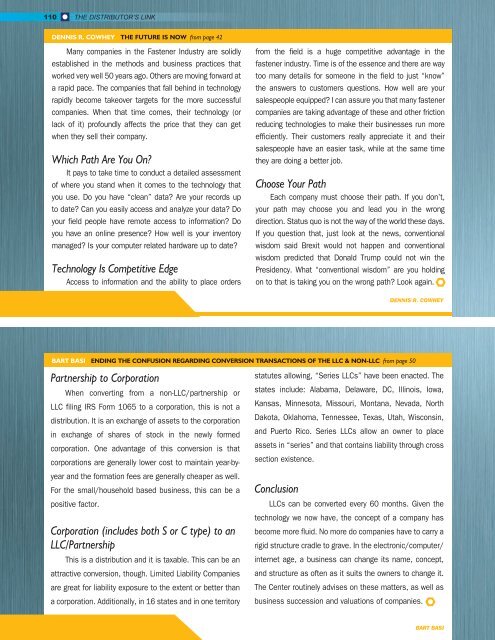WINTER 2017
Distributor's Link Magazine Winter Issue 2017 / Vol 40 No1
Distributor's Link Magazine Winter Issue 2017 / Vol 40 No1
You also want an ePaper? Increase the reach of your titles
YUMPU automatically turns print PDFs into web optimized ePapers that Google loves.
110<br />
THE DISTRIBUTOR’S LINK<br />
DENNIS R. COWHEY THE FUTURE IS NOW from page 42<br />
Many companies in the Fastener Industry are solidly<br />
established in the methods and business practices that<br />
worked very well 50 years ago. Others are moving forward at<br />
a rapid pace. The companies that fall behind in technology<br />
rapidly become takeover targets for the more successful<br />
companies. When that time comes, their technology (or<br />
lack of it) profoundly affects the price that they can get<br />
when they sell their company.<br />
Which Path Are You On?<br />
It pays to take time to conduct a detailed assessment<br />
of where you stand when it comes to the technology that<br />
you use. Do you have “clean” data? Are your records up<br />
to date? Can you easily access and analyze your data? Do<br />
your field people have remote access to information? Do<br />
you have an online presence? How well is your inventory<br />
managed? Is your computer related hardware up to date?<br />
Technology Is Competitive Edge<br />
Access to information and the ability to place orders<br />
from the field is a huge competitive advantage in the<br />
fastener industry. Time is of the essence and there are way<br />
too many details for someone in the field to just “know”<br />
the answers to customers questions. How well are your<br />
salespeople equipped? I can assure you that many fastener<br />
companies are taking advantage of these and other friction<br />
reducing technologies to make their businesses run more<br />
efficiently. Their customers really appreciate it and their<br />
salespeople have an easier task, while at the same time<br />
they are doing a better job.<br />
Choose Your Path<br />
Each company must choose their path. If you don’t,<br />
your path may choose you and lead you in the wrong<br />
direction. Status quo is not the way of the world these days.<br />
If you question that, just look at the news, conventional<br />
wisdom said Brexit would not happen and conventional<br />
wisdom predicted that Donald Trump could not win the<br />
Presidency. What “conventional wisdom” are you holding<br />
on to that is taking you on the wrong path? Look again.<br />
DENNIS R. COWHEY<br />
BART BASI ENDING THE CONFUSION REGARDING CONVERSION TRANSACTIONS OF THE LLC & NON-LLC from page 50<br />
Partnership to Corporation<br />
When converting from a non-LLC/partnership or<br />
LLC filing IRS Form 1065 to a corporation, this is not a<br />
distribution. It is an exchange of assets to the corporation<br />
in exchange of shares of stock in the newly formed<br />
corporation. One advantage of this conversion is that<br />
corporations are generally lower cost to maintain year-byyear<br />
and the formation fees are generally cheaper as well.<br />
For the small/household based business, this can be a<br />
positive factor.<br />
Corporation (includes both S or C type) to an<br />
LLC/Partnership<br />
This is a distribution and it is taxable. This can be an<br />
attractive conversion, though. Limited Liability Companies<br />
are great for liability exposure to the extent or better than<br />
a corporation. Additionally, in 16 states and in one territory<br />
statutes allowing, “Series LLCs” have been enacted. The<br />
states include: Alabama, Delaware, DC, Illinois, Iowa,<br />
Kansas, Minnesota, Missouri, Montana, Nevada, North<br />
Dakota, Oklahoma, Tennessee, Texas, Utah, Wisconsin,<br />
and Puerto Rico. Series LLCs allow an owner to place<br />
assets in “series” and that contains liability through cross<br />
section existence.<br />
Conclusion<br />
LLCs can be converted every 60 months. Given the<br />
technology we now have, the concept of a company has<br />
become more fluid. No more do companies have to carry a<br />
rigid structure cradle to grave. In the electronic/computer/<br />
internet age, a business can change its name, concept,<br />
and structure as often as it suits the owners to change it.<br />
The Center routinely advises on these matters, as well as<br />
business succession and valuations of companies.<br />
BART BASI

















